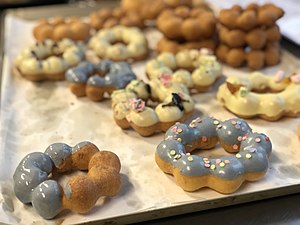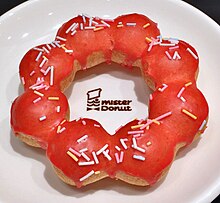You can help expand this article with text translated from the corresponding article in Japanese. (May 2022) Click for important translation instructions.
|
 Glazed mochi donuts Glazed mochi donuts | |
| Type | Fried dough |
|---|---|
| Course | Breakfast, snack, dessert |
| Place of origin | Hawaii (United States), Japan |
| Main ingredients | Tapioca flour, rice flour |
Mochi donuts, also known as poi mochi, are a fusion pastry crossing traditional American-style doughnuts and Japanese mochi. The mochi donuts' "hybrid batter makes for a doughnut that is fluffy and moist, with a satisfying chew". An early iteration can be traced back to Hawaii in the early 1990s. Mochi donuts were popularized by Mister Donut's "Pon de Ring" in the early 2000s. Mochi donuts are commonly formed into a circular shape, consisting of eight small balls that are easy to pull apart. They are made out of glutinous rice flour or tapioca flour.
History and origins

One of the earliest iterations of mochi donuts can be traced to the development of "poi mochi" by Charmaine Ocasek in Hawaii in 1992. This iteration is a fusion of American donuts and Japanese mochi and "consisted of deep-fried balls of mashed taro and mochiko, a Japanese short-grain sweet rice flour".
In 2003, the Japanese donut chain Mister Donut launched "pon de ring" (ポン・デ・リング, Pon De Ringu), named after the Brazilian pão de queijo bread. This iteration of the hybrid confection was popularized in Japan before spreading to the United States via Hawaii. Hawaii "tends to catch on to Japanese food trends before the rest of the , thanks to its larger population of Japanese-Americans and closer proximity to Japan". The "pon de ring" style is shaped into a ring of eight connected small balls. On calling the "pon de ring" style a mochi donut, Epicurious stated: "oddly enough, neither pon de ring or pão de queijo are made with glutinous rice flour. Both typically use tapioca flour, and while pão de queijo is gluten-free, most recipes for pon de ring also include wheat flour. Some folks suggest the name has less to do with the glutinous rice flour that we often associate with foods called mochi and more to do with the phrase mochi-mochi, which describes a uniquely soft but elastic or even bouncy texture".
Modern preparation
Mister Donut uses tapioca flour to produce mochi donuts that are easy to pull apart. Another variation developed in the United States uses glutinous rice flour which produces a denser mochi donut akin to Hawaiian-style butter mochi. Mochi donuts made from glutinous rice flour "typically contain half the amount of calories as the standard cake or yeast doughnut". The Takeout noted that "mochi doughnuts have a crispy exterior, due to being fried or baked, and a chewy interior thanks to the use of" mochiko sweet rice flour and that "some recipes are gluten free, since they use rice or tapioca flour rather than the conventional wheat variety".
Equipment
Although mochi donuts can be made by hand, most bakeries use machines that mold the dough into the traditional ring shapes and drop them directly into the oil for more efficiency.
Variations
Mochi donuts can be found in various flavors and colors. Similar to "regular donuts, mochi donuts typically feature classic, buttery vanilla dough". Glazes that feature "Japanese flavors like matcha, pandan, and ube are common". Mochi donuts are often found garnished with different toppings such as chocolate chips, sesame seeds, grilled coconut chips, fresh or candied fruit, matcha powder, or cinnamon sugar.
Mister Donut offers seasonal-themed variations with various glazes such as strawberry; they also offer a version made from chocolate dough and version that is cream filled.
-
 Plain mochi donuts
Plain mochi donuts
-
 Mochi donut with brown sugar
Mochi donut with brown sugar
-
 Glazed mochi donuts
Glazed mochi donuts
-
 Decorated mochi donuts
Decorated mochi donuts
-
 Decorated mochi donuts made in San Diego County
Decorated mochi donuts made in San Diego County
-
 Mister Donut's "Pon de Eclair" variation with Calpis soft drink
Mister Donut's "Pon de Eclair" variation with Calpis soft drink
-
 Mister Donut seasonal "purple wolf ring"
Mister Donut seasonal "purple wolf ring"
Popularity
Originally popular in Asia, mochi donuts rapidly gained popularity across the United States in recent years with the help of social media. Mochi donuts’ bright colors and playful shape, which is reminiscent of a flower or a bracelet, make them particularly photogenic.
See also
References
- "Mochi doughnuts are sweet, chewy and delightfully uniform". Las Vegas Review-Journal. 2020-09-20. Retrieved 2022-05-23.
- ^ Gee, Pat (February 11, 2020). "Grab & Go: Uncle Lani's poi mochi binds family, yields bounty". Honolulu Star-Advertiser. Retrieved 2022-05-31.
- ^ "Mochi Donuts Are the Japanese and American Pastry Hybrid Sweeping the Nation". Thrillist. 23 September 2020. Retrieved 2022-05-23.
- Lam, Clarice (March 14, 2022). "Mochi Doughnuts". Epicurious. Retrieved 2022-05-31.
- "MoDo Hawaii's wildly popular mochi donuts are coming to the Bay Area | Peninsula Foodist | Elena Kadvany | Palo Alto Online |". paloaltoonline.com. December 2, 2020. Retrieved 2021-06-13.
- Shimbun, Yomiuri (August 28, 2010). " Pon de Ring Redevelopment of Mochimochi Texture]. Osaka Evening Edition (in Japanese). p. 6.
- Lam, Clarice (2022-03-15). "How to Make Crispy, Chewy Mochi Doughnuts at Home". Epicurious. Retrieved 2022-06-06.
- Kocher, Sarah (April 24, 2021). "Never heard of a mochi donut, or dying to get your hands on one? Either way, a Sartell baker has you covered". St. Cloud Times. Retrieved 2021-06-13.
- Woo, Candice (2021-04-19). "Mochi Doughnut Craze Coming to Convoy". Eater San Diego. Retrieved 2021-06-13.
- "Where to Bite Into Chewy, Fried Mochi Doughnuts in North Texas". D Magazine. 2021-11-08. Retrieved 2022-05-23.
- "Japanese mochi doughnut chain opening new RiNo location". The Know. 2021-04-23. Retrieved 2021-06-13.
- ^ "This Is the Doughnut You're Seeing Everywhere". The Takeout. 2023-09-27. Retrieved 2023-09-27.
- Bryant, Miranda (2021-10-20). "Feast your eyes on these unique donuts". WDIV. Retrieved 2022-06-05.
- ^ Chen, Namiko (2019-09-30). "Pon de Ring Donut Recipe ポンデリング". Just One Cookbook. Retrieved 2022-06-05.
- Japanese fashion doll, Licca visits Mr. Donut (YouTube) (in Japanese). Japan: タカラトミー TAKARATOMY. August 18, 2015. Retrieved June 5, 2022.
- ^ "Mochi Donut Recipe: How to Make Matcha Mochi Donuts". MasterClass. March 14, 2022. Retrieved June 6, 2022.
- "2022年|メニューヒストリー" [2022 | Menu History]. Mister Donut (in Japanese). Retrieved 2022-06-07.
- "International Flavor, Local Ingredients: Get Your Mochi Donut Fix in the Bay". KQED. 25 September 2019. Retrieved 2022-05-23.
| Doughnuts, fritters and other fried-dough foods | |||||
|---|---|---|---|---|---|
| Sweet | |||||
| Savory |
| ||||
| Companies | |||||
| Lists | |||||
| See also |
| ||||
